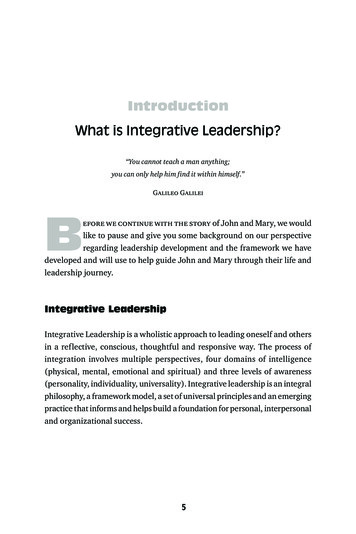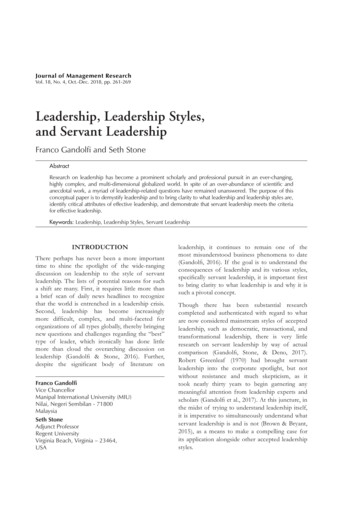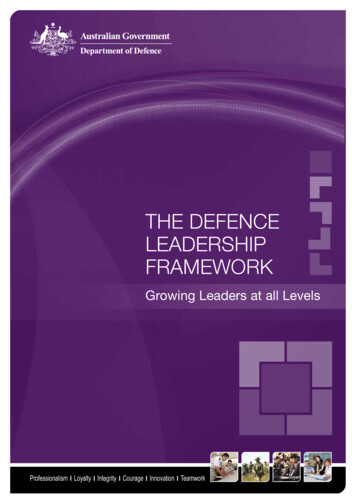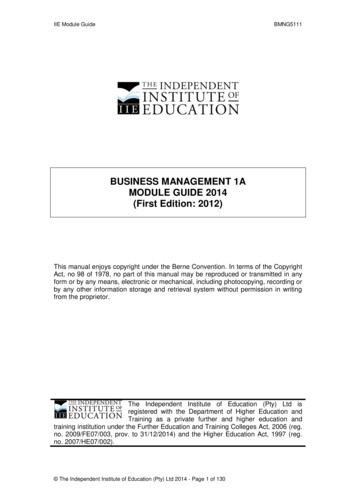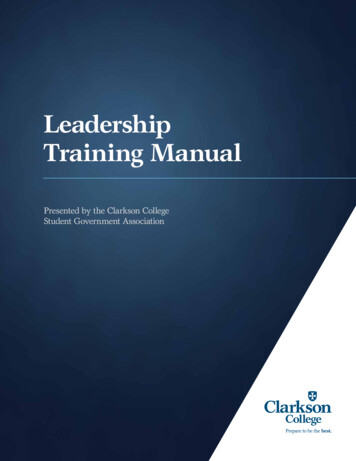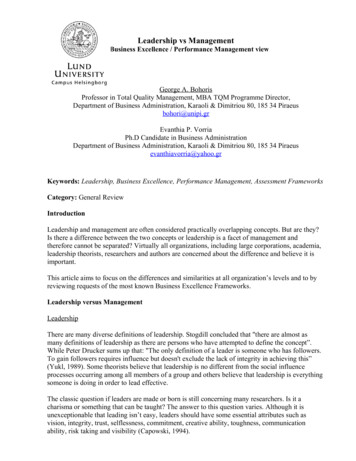
Transcription
Leadership vs ManagementA Business Excellence / Performance Management viewGeorge A. BohorisProfessor in Total Quality Management, MBA TQM Programme Director,Department of Business Administration, Karaoli & Dimitriou 80, 185 34 Piraeusbohori@unipi.grEvanthia P. VorriaPh.D Candidate in Business AdministrationDepartment of Business Administration, Karaoli & Dimitriou 80, 185 34 Piraeusevanthiavorria@yahoo.grKeywords: Leadership, Business Excellence, Performance Management, Assessment FrameworksCategory: General ReviewIntroductionLeadership and management are often considered practically overlapping concepts. But are they?Is there a difference between the two concepts or leadership is a facet of management andtherefore cannot be separated? Virtually all organizations, including large corporations, academia,leadership theorists, researchers and authors are concerned about the difference and believe it isimportant.This article aims to focus on the differences and similarities at all organization’s levels and to byreviewing requests of the most known Business Excellence Frameworks.Leadership versus ManagementLeadershipThere are many diverse definitions of leadership. Stogdill concluded that "there are almost asmany definitions of leadership as there are persons who have attempted to define the concept”.While Peter Drucker sums up that: "The only definition of a leader is someone who has followers.To gain followers requires influence but doesn't exclude the lack of integrity in achieving this”(Yukl, 1989). Some theorists believe that leadership is no different from the social influenceprocesses occurring among all members of a group and others believe that leadership is everythingsomeone is doing in order to lead effective.The classic question if leaders are made or born is still concerning many researchers. Is it acharisma or something that can be taught? The answer to this question varies. Although it isunexceptionable that leading isn’t easy, leaders should have some essential attributes such asvision, integrity, trust, selflessness, commitment, creative ability, toughness, communicationability, risk taking and visibility (Capowski, 1994).
ManagementSome would define management as an art, while others would define it as a science. Whethermanagement is an art or a science isn't what is most important. Management is a process that isused to accomplish organizational goals. that is, a process that is used to achieve what anorganization wants to achieve.But do leaders and managers have the same role? Can organizations have only leaders or onlymanagers?A well balanced organization should have a mix of leaders and managers to succeed, and in factwhat they really need is a few great leaders and many first-class managers (Kotterman, 2006)Managers and Leaders: Are they different?Managers are the people to whom this management task is assigned, and it is generally thoughtthat they achieve the desired goals through the key functions of planning and budgeting,organizing and staffing, problem solving and controlling. Leaders on the other hand set adirection, align people, motivate and inspire (Kotter, 2001).Other researchers consider that a leader has soul, the passion and the creativity while a managerhas the mind, the rational and the persistence. A leader is flexible, innovative, inspiring,courageous and independent and at the same time a manager is consulting, analytical, deliberate,authoritative and stabilizing (Capowski, 1994).The most important differences between leaders and managers concern the workplace and areconcluded in table I:ProcessVision EstablishmentManagement Plans and budgets Develops process steps andsets timelines Displays impersonal attitudeabout the vision and goalsHuman Development andNetworking Vision Execution Controls processes Identifies problems Solves problemsOrganizes and staffsMaintains structureDelegate responsibilityDelegates authorityImplements the visionEstablishespolicyandprocedures to implementvision Displays low emotion Limits employee choicesLeadership Sets direction and developthe vision Develops strategic plansand achieve the vision Displays very passionateattitude about the visionand goals Align organization Communicates the vision,mission and direction Influences creation ofcoalitions, teams andpartnershipsthatunderstand and accept thevision Displays driven, highemotion Increases choices Motivates and inspires Energizes employees toovercome barriers to
Monitor results Takes low risk approach toproblem solvingchange Satisfies basic humanneeds Takes high risk approachto problem solvingVision Outcome Managers vision order and Promotesusefulandpredictabilitydramatic changes, such as Provides expected resultsnewproductsorconsistently to leadership andapproaches to improvingother stakeholderslabor relationsTable I: Comparison of Management and Leadership Process Differences in the workplace(Kotterman,2006).Leadership and Management in TQM and Excellent OrganizationsTotal Quality Management is a philosophy based on a set of principles, as customer focus,continuous improvement, everyone’s involvement and management by fact. TQM literature alsohighlights management’s commitment and leadership as determining factor for the implementationof this management philosophy and the basic precondition in order to succeed Business Excellence(Gonzàlez, Guillèn, 2001).A research project started in 1996 by Jim Collins and his research team shows that companies thathad shifted from good performance to great performance and sustained it follow a particularmodule of leadership and management hierarchy, known as Level 5.Level 5 Hierarchy means that in a organization managers and leaders exist with different forms,roles and responsibilities: Level 1: Highly Capable Individuals - Makes productive contributionsthrough talent, knowledge, skills, and good work habits, Level 2: Contributing Team Member-Contributes to the achievement of group objectives, works effectively with others in a groupsetting, Level 3: Competent Manager - Organizes people and resources toward the effective andefficient pursuit of predetermined objectives, Level 4: Effective Leader - Catalyzes commitment toand vigorous pursuit of a clear and compelling vision; stimulates the group to high performancestandards, and Level 5: Level 5 Executive - Builds enduring greatness through a paradoxicalcombination of personal humility plus professional will (Collins, 2001).Business/ Performance Excellence and Leadership-ManagementIn the early 80’s when everyone was talking about quality and business excellence manyframeworks and performance models derived. Leadership was a basic concept in all theseframeworks with a direct or indirect impact.In the Australian Quality Award Leadership Criteria examine the role of management in creatingvalues and developing an appropriate management system to make them a reality. MalcolmBaldridge Award and European Foundation for Quality Management (EFQM) BusinessExcellence Model have an extend report to leadership criterion (Edgeman, Rodgers, 1999). Lateron some new Performance Management systems arrive (Performance Pyramid, PerformancePrism, a.o.) where management involvement and leadership commitment are still a basic aspectbehind the deployment of all their requests, but not with a clear and obvious way, as theframeworks mentioned before.
It can be argued as to whether "management" and "leadership" in these models are the equivalent.This article aims to distinguish these two concepts by reviewing the relevant requests of some ofthe wider known Business Excellence Frameworks. EFQM Excellence ModelThe EFQM Excellence Model is framework based on 9 criteria. The first five are “Enablers” andthe last four are “Results”. The “Enabler” criteria cover what an organisation does. The “Results”criteria cover what an organisation achieves. There are two approaches to explain the model. Oneapproach is based on the idea that the results are caused by the “Enablers” and the second enablersare improved using feedback from “Results”. The Model is based on the premise that:Excellent results with respect to Performance, Customers, People and Society are achievedthrough Leadership driving Policy and Strategy, that is delivered through People, Partnershipsand Resources, and Processes. (www.efqm.org). The EFQM Model is presented in Figure 1.The percentage given in each box in figure 1 identifies the proportion of each criterion in theaward assessment system of the European Quality Award. As it is shown leadership criterion has aweight of 10%, which is the second highest weight for the Enablers. That means that ExcellentOrganizations are highly dependant of good eadership10%Policy ips& %Innovation & LearningFigure 1: The EFQM Excellence Model (www.efqm.org)For EFQM, leadership relates to the behavior of the executive team and all other levels ofmanagement in as much as how leaders develop mission and vision and values, are personallyinvolved, support continuous improvement, are involved with stakeholders, motivate andrecognize employees loyalty and efforts and identify and set direction for change (Wongrassamee,Gardiner and Simmons, 2003).Leadership criterion in EFQM Model refers mainly to Level 5 Hierarchy: Executives. But a moresevere study of the model indicates that also management in all levels plays an important role inthe criteria of enablers in EFQM Model.People Management is the third criterion of EFQM Model and refers to how organizationsmanage, develop and release the full potential of their people at an individual, team-based andorganizational level. With a weight of 9% this criterion proves that management in all levels, as anindividual, as a team member and as competent manager and effective leader, effects this aspect of
the framework, as well. Partnership and Resources the forth criterion indicates the aboveconclusion, as all partnerships and resources need effective leaders and capable manager in orderto be administrated. Finally, processes is the criterion with the highest proportion in theassessment system (14%). It refers to how organizations design, manage and improve theprocesses intending to satisfy its stakeholders. TQM and Business Excellence philosophyunderlines the importance of everyone’s involvement in processes and procedures design, in orderto meet customers’ (internal and external) expectations. Therefore, it is really important to identifyleadership contribution in the journey for succeeding Business Excellence but first line managers’,team managers’, and individuals’ offer must not be ignored or underestimated. Balanced ScorecardIn early 90’s David Norton and Robert Kaplan came up with a comprehensive framework namedBalanced Scorecard. Aim of this framework is to give managers and leaders a comprehensive viewof the business and allow them to focus on critical areas, as customer perspective, financialperspective, Internal Business perspective and Innovation and Learning (Wongrassamee, Gardinerand Simmons, 2003). The balance Scorecard is shown in Figure 2.Financial PerspectiveGoalsMeasuresHow do we look toour stakeholders?How do customers see us?What must we excel at?Customer PerspectiveGoalsInternal Business PerspectiveMeasuresGoalsMeasuresInnovation & LearningGoalsMeasuresCan we continue toimprove and create value?Figure 2: The Balanced Scorecard (Kaplan, Norton, 2005)This framework does not have direct requests for leadership commitment and managerinvolvement. But studying it in depth, different conclusions are emerging. Balanced Scorecarddemands that managers translate customer requests into specific measurements. Customers wantgood time, quality, performance and service. To put this framework to work leaders should beaware of these four requirements and determine relevant goals. Managers in all levels should alsofocus on those critical internal business processes that enable them to satisfy customers. Leaderson the other hand, have to identify their company’s core competencies and critical technologiesneeded and give all the resources in order to succeed customer delight. But the targets for successkeep changing. Global market and strong competition command organizations to make continuousimprovements to their existing products/services and processes and have the ability to introducenew products into the market. Leaders have the responsibility to identify the need for change andset the directions, when managers should participate in this procedure and suggest solutions. Atlast financial performance is regarding to leaders and managers. Leaders need to know how the
organization is going and develop the policy and strategy, while managers should know the resultsof the operational actions and their areas for improvement (Kaplan and Norton 1993, 2005). Performance Pyramid or “SMART” SystemThe Strategic Measurement Analysis and Reporting Technique (SMART) system was proposed byCross and Lynch in 1992, as a result of dissatisfaction with traditional performance measures suchas productivity and financial variances. The objective was to devise a management control systemwith performance indicators designed to define and sustain success (Ghalayini, Noble, 1996).The Performance Pyramid includes four levels of objectives that address the organization’seffectiveness and its internal efficiency. As it is shown in figure 3, there isn’t a direct request forleadership and management involvement. Nevertheless, leaders develop vision (first level of thesystem) and they translate stakeholders’ needs into individual business and unit objectives. Thesecond level of the pyramid indicates that managers set short-term targets when leaders determinelong term goals of growth and market position. Middle managers bridge the gap between top-levelmeasures and day-to-day operational measures, as customer satisfaction, flexibility andproductivity. Finally, first line managers measure on a daily basis indicators that effectperformance, as quality, delivery, cycle time and waste (Tangen, sFinancialMeasuresBusiness UnitBusinessOperating partmentand workcentresQualityDeliveryProcess TimeCostOperationsFigure 3: The Performance Pyramid (Neely, Bourne, Kennerley, 2000) Performance PrismThe Performance Prism (Figure 4) is a performance measurement framework that addresses thekey business issues to which a wide variety of organizations, will be able to relate. It asks criticalquestions and encourages managers and leaders to think through the links between measures in away that other frameworks do not intuitively suggest (Neely, Adams and Crowe, 2001).
Stakeholders SatisfactionStrategiesCapabilitiesProcesses CorporateBusiness UnitBrands/Products/ServicesOperating PeoplePracticesTechnologyInfrastractureDevelop Products & ServicesGenerate DemandFulfill DemandPlan & Manage EnterpriseStakeholders ContributionFigure 4: The Performance Prism (Neely, Adams and Crowe, 2001)This framework suggests that stakeholders’ wants and needs must be considered first. Then leaderscan formulate the strategies, identify capabilities and plan processes (Tangen, 2004). When on theother hand managers of all levels participate in the procedures and follow instructions.ConclusionBased on the above it is obvious that there is an underlying strong request for leadership, even inthe areas where the request is either verbally or actually of a managerial nature. Managers of alllevels play an important role in the development of a self assessment project through the knownBusiness Excellence/ Performance Evaluation Models and have a high impact on theorganizations’ journey to Excellence. Further research on how organizations comprehend thisstrong request of leadership involvement and commitment and how do excellent organizationsmanage to sustain the competitive advantage is important to be held out. Nevertheless, it cannot bedebatable that the contribution of leadership and management on the organizations’ success is highand it is clearly shown by reviewing the wider known Business Excellence / PerformanceManagement/Assessment Frameworks and Models.ReferencesCapowski, G., (1994), “Anatomy of a leader: where are the leader of tomorrow?”, ManagementReview, Vol. 83 Issue 3, p.10-18Collins, J., (2001), “Level 5 Leadership, The Triumph of humility and fierce resolve”, HarvardBusiness Review, Vol. 79 Issue 1, p.66-76Edgeman R.L., Rodgers T., (1999), “ Leadership ESCAPE FROM Organizational Nihilism:Leadership Core Values for Business Excellence”, International Journal of Applied QualityManagement, Vol. 2 No 1, p. 117-125Ghalayini A.M., Noble J. S., (1996), “The changing basis of performance measurement”,International Journal of Operations & Production Management, Vol. 16 No. 8 1996, p. 6380.González T.F., Guillén M., (2002), “Leadership ethical dimension: a requirement in TQMimplementation”, The TQM Magazine , vol. 14 Issue 3, pp. 150 – 164.Kaplan R.S., Norton D. P., (1993), “Putting the Balanced Scorecard to Work”, Harvard BusinessReview, Vol. 71 Issue 5, p. 134-147Kaplan R.S., Norton D. P., (2005), “The Balanced Scorecard: Measures that drive performance”,Harvard Business Review, Vol. 83 Issue 7/8, p. 172-180
Kotter, J. P., (2001), “What leaders really do?“, Harvard Business Review, Vol. 79 Issue 11, p.8596Kotterman, J., (2006), “Leadership vs Management: What’s the difference?”, Journal for Quality& Participation, Vol. 29 Issue 2, p.13-17Neely A., Adams C. and Crowe P., (2001), "The Performance Prism in Practice”, MeasuringBusiness Excellence, Vol. 5 No 2, p. 6-12Neely A., Adams C., (2000), “The Performance Prism to boost M&A Success”, MeasuringBusiness Excellence, Vol. 4 No 3, p. 19-23Neely A., Mills J., Platts K., Richards H., Gregory M., Bourne M., Kennerley M., (2000),“Performance measurement system design; developing and testing a process-basedapproach”, International Journal of Operations & Production Management, Vol. 20 No. 10,p. 63-80.Tangen S., (2004), “Performance measurement: from philosophy to practice”, InternationalJournal of Productivity and Performance Management, Vol. 53 No. 8, 2004 p. 726-737Wongrasamee S., Gardiner P.D., Simmons J.E.L., (2003), “Performance Measurement tools: theBalanced Scorecard and EFQM Excellence Model”, Measuring Business Excellence, Vol. 7No 1, p. 14-29Yukl, G., (1989), “Managerial Leadership: a review of theory and research”, Journal ofManagement, Vol. 15 Issue 2, p.251-290www.efqm.org
values and developing an appropriate management system to make them a reality. Malcolm Baldridge Award and European Foundation for Quality Management (EFQM) Business Excellence Model have an extend report to leadership criterion (Edgeman, Rodgers, 1999). Later on some new Performance Management systems arrive (Performance Pyramid, Performance

